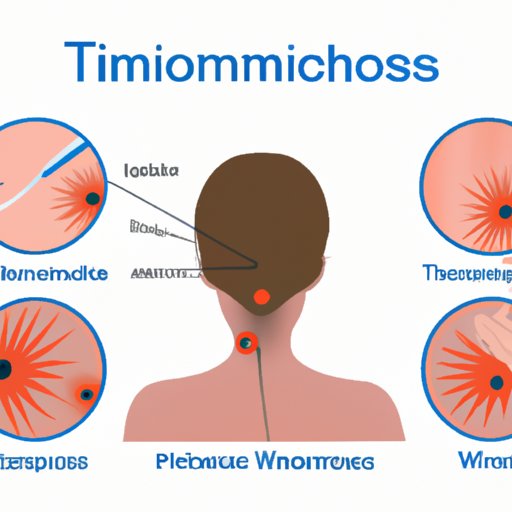
Introduction
Trichomoniasis is a common sexually transmitted infection (STI) caused by a parasite. Although both men and women can contract it, women are particularly susceptible to the infection. In this article, we will take a closer look at the signs and symptoms of trichomoniasis, how to identify them, and why seeking medical attention is crucial.
Definition of Trichomoniasis
Trichomoniasis is an STI caused by a single-celled parasite, Trichomonas vaginalis. It can be transmitted through sexual contact, including vaginal, oral, and anal sex.
Importance of Identifying Symptoms
Identifying symptoms of trichomoniasis is important because early detection can reduce the risk of complications, including the increased risk of contracting other STIs. Moreover, prompt treatment can help prevent the spread of the infection to others.
Overview of Article Topics
In this article, we will explore the top ten common symptoms of trichomoniasis and how they manifest in both men and women. We will also discuss ways to identify these symptoms, the importance of seeking medical attention, and available treatments.
10 Common Symptoms of Trichomoniasis: Everything You Need to Know
Overview of the 10 Common Symptoms
Common symptoms of trichomoniasis include:
- itching or burning sensation in the genital area
- abnormal discharge that is frothy, yellow-green, or unpleasant smelling
- pain or discomfort during sex or while urinating
- swelling, redness, or soreness in the genital area
- lower abdominal pain (women) or pain in the testicles (men)
- spotting or bleeding between periods (women)
- increased urge to urinate
- fever
- nausea and vomiting
- general malaise or fatigue
In-depth Explanation of Each Symptom
Itching or burning sensation in the genital area: Both men and women can experience itching, burning, or tingling in the genital area if they have trichomoniasis. This is often accompanied by redness or swelling in the affected areas and can be quite uncomfortable.
Abnormal discharge that is frothy, yellow-green, or unpleasant smelling: Women with trichomoniasis often experience a change in their vaginal discharge. Normal discharge is clear or white, thin and watery, and odorless. With trichomoniasis, the discharge can become thicker, more abundant, and yellow-green in color. It may also have an unpleasant odor.
Pain or discomfort during sex or while urinating: Pain or discomfort is common during sex or while urinating if you have trichomoniasis. This may be due to inflammation or irritation in the affected areas.
Swelling, redness, or soreness in the genital area: The genital area may become swollen, red, or sore due to the inflammation caused by the trichomoniasis parasite.
Lower abdominal pain (women) or pain in the testicles (men): Men and women with trichomoniasis may experience lower abdominal pain or discomfort. Women may also experience pain during sexual intercourse and men may experience pain or swelling in the testicles.
Spotting or bleeding between periods (women): Women with trichomoniasis may experience spotting or bleeding between periods, as well as after intercourse.
Increased urge to urinate: Both men and women may experience an increased urge to urinate and may pass smaller amounts of urine more frequently.
Fever: Fever is a less common symptom of trichomoniasis but can occur in severe cases.
Nausea and vomiting: In rare cases, trichomoniasis may cause nausea and vomiting.
General malaise or fatigue: The infection may cause a general feeling of weakness, fatigue, and malaise.
Importance of Recognizing Multiple Symptoms
It is important to recognize multiple trichomoniasis symptoms since some may be mild or absent in some individuals. Experiencing multiple symptoms can provide a clearer indication of trichomoniasis infection, which can help in seeking proper diagnosis and treatment.
Discovering the Telltale Signs: How to Identify Trichomoniasis Symptoms
Tips for Identifying Trichomoniasis Symptoms
If you suspect you may have trichomoniasis, you should look out for the symptoms listed above. Diagnosis is usually made by a healthcare provider. If you experience any of the symptoms, you should consult with your healthcare provider promptly.
Explanation of How Symptoms Differ Between Men and Women
The symptoms of trichomoniasis can differ between men and women. Men commonly experience urethritis, which is inflammation of the urethra. This can cause pain and discharge from the penis. In women, trichomoniasis can cause vaginitis, which is inflammation of the vagina. This can cause itching, burning, and discharge from the vagina.
Importance of Seeking Medical Attention for Accurate Diagnosis
It is important to seek medical attention if you experience any of the symptoms associated with trichomoniasis. However, it is also important not to self-diagnose since the symptoms of trichomoniasis are similar to those of other STIs and vaginal infections. A thorough medical examination and diagnostic tests are necessary to accurately diagnose and treat trichomoniasis.
From Itching to Discharge: What You Need to Know About Trichomoniasis Symptoms
Explanation of Itching and Discharge Symptoms
Two of the most common symptoms of trichomoniasis are itching and discharge. Itching can be mild or intense and can occur in either men or women due to the inflammation of the affected areas. Discharge, on the other hand, is usually yellow-green and may have a strong odor.
Importance of Understanding How Trichomoniasis is Transmitted
Trichomoniasis is transmitted primarily through sexual activity. It can be passed during vaginal, anal, or oral sex or through genital contact with an infected partner. It is important to practice safe sex by using condoms, getting tested for STIs regularly, and avoiding sexual activity with partners who have a known STI.
Explanation of How Symptoms Can Vary in Severity
Trichomoniasis symptoms can vary in severity depending on the individual. Some people may experience mild symptoms or no symptoms at all while others may have severe symptoms. Symptoms can also be intermittent, meaning they come and go over time. It is important to monitor symptoms and seek medical attention if they persist or become severe.
When to See a Doctor: Understanding Trichomoniasis Symptoms
Importance of Seeking Medical Attention for Accurate Diagnosis
It is crucial to seek medical attention if you suspect you may have trichomoniasis. A healthcare provider can accurately diagnose and treat the infection, as well as provide advice on preventing the spread of the infection to others.
Explanation of Potential Complications if Left Untreated
If left untreated, trichomoniasis can cause serious complications, including an increased risk of contracting other STIs, preterm birth, and low birth weight in pregnant women, and an increased risk of transmitting the infection to sexual partners.
Overview of Diagnostic Tests and Treatments
Diagnosis of trichomoniasis is usually done through a medical examination and laboratory tests, including a pelvic exam, urethral swab, or urine test. Treatment usually involves antibiotics, which can quickly clear the infection. Your healthcare provider may also recommend retesting after treatment to ensure the infection has been fully cleared.

Trichomoniasis Symptoms: A Comprehensive Overview of the Infection
Overview of What Causes Trichomoniasis
Trichomoniasis is caused by the Trichomonas vaginalis parasite, which is transmitted through sexual activity.
Explanation of How Trichomoniasis is Transmitted
Trichomoniasis is transmitted primarily through sexual activity, including vaginal, anal, or oral sex, and genital contact with an infected partner.
Importance of Practicing Safe Sex to Prevent Infection
Practicing safe sex is an important way to prevent trichomoniasis and other STIs. This includes using condoms, getting tested for STIs regularly, and avoiding sexual activity with partners who have a known STI.
The Unsettling Symptoms of Trichomoniasis: A Guide for Women and Men
Explanation of How Trichomoniasis Affects Men and Women Differently
Although both men and women can contract trichomoniasis, they may experience different symptoms. Men may experience urethritis, and women may experience vaginitis, which can cause itching, burning, and discharge.
Overview of How Symptoms Can Impact Sex Life
The symptoms of trichomoniasis can have a considerable impact on a person’s sex life, causing discomfort, pain, and inflammation. It can also be embarrassing and affect a person’s mental well-being.
Importance of Open Communication with Sexual Partners
Open communication with sexual partners is crucial when dealing with trichomoniasis. It is important to inform your partner if you have been diagnosed with the infection and to take steps to avoid spreading it.
Trichomoniasis Symptoms and Treatment: What to Expect
Explanation of Common Treatments for Trichomoniasis
Treatment for trichomoniasis usually involves antibiotics. Metronidazole is the most commonly prescribed medication for trichomoniasis and can be taken orally or topically, depending on the severity of the infection.
Overview of Potential Side Effects of Treatment
Common side effects of trichomoniasis treatment include diarrhea, nausea, vomiting, and abdominal pain. Some individuals may also experience a metallic taste in their mouth or a rash.
Importance of Proper Follow-Up Care to Prevent Re-Infection
Proper follow-up care is important to prevent re-infection and ensure that the infection has been fully cleared. This may involve retesting after treatment and using condoms or practicing abstinence until treatment is completed.
Conclusion
Recap of Article Topics
Trichomoniasis is a common STI caused by the Trichomonas vaginalis parasite. Symptoms can vary in severity and include itching, discharge, and pain during sex or urination. It is important to seek medical attention if you experience any symptoms to accurately diagnose and treat the infection.
Emphasis on Importance of Identifying and Treating Symptoms
Early detection and treatment of trichomoniasis is crucial for reducing the risk of complications and preventing the spread of the infection to others. Practicing safe sex and getting tested regularly for STIs can also help prevent the spread of trichomoniasis.
Call to Action for Seeking Medical Attention if Experiencing Symptoms
If you suspect you may have trichomoniasis, you should seek medical attention promptly. Your healthcare provider can diagnose and treat the infection and provide advice on preventing re-infection and spreading the infection to others.





